Clovers are annual or perennial forbs in the Trifolium genus of the pea family. Many of them are native to the Yuba-Sutter area, and many of the non-native ones are common garden weeds in the Yuba-Sutter area. Non-native clovers that are common garden weeds here include shamrock clover, strawberry clover, clustered clover, crimson clover, red clover, white clover, knotted clover, and subterranean clover.
Clovers are a larval host plant for the local orange sulfur butterfly. In addition, the local lustrous copper and common sootywing butterflies drink the nectar of clover flowers.
Some plants that are not actually clovers are often called clovers. For example, many paintbrushes are often called owl's clovers, California spikenard is often called elk's clover, Sierra mountain misery is often called bearclover.
Perennials
Forest Clover
Forest clover is native to Yuba County and typically grows at elevations below 7,000 feet. It is most often found on slopes in yellow pine forest.
You can see pictures of it at CalPhotos, Flickr, and Picasa.
Springbank Clover
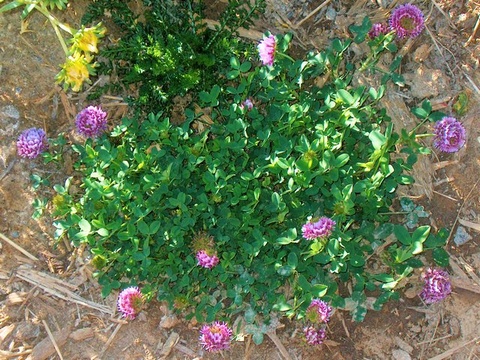 Springbank clover (Trifolium wormskioldii) blooms in a garden in Marysville and gets photobombed by hairy gumplant (Grindelia hirsutula). Photo by queerbychoice. Springbank clover (also called cow clover) is native to Yuba and Sutter Counties and typically grows at elevations below 10,000 feet. It is found in riparian forest.
Springbank clover (Trifolium wormskioldii) blooms in a garden in Marysville and gets photobombed by hairy gumplant (Grindelia hirsutula). Photo by queerbychoice. Springbank clover (also called cow clover) is native to Yuba and Sutter Counties and typically grows at elevations below 10,000 feet. It is found in riparian forest.
You can see pictures of it at CalPhotos, Flickr, and Picasa. You can find out where to buy it at the California Native Plant Link Exchange.
Annuals
Sour Clover
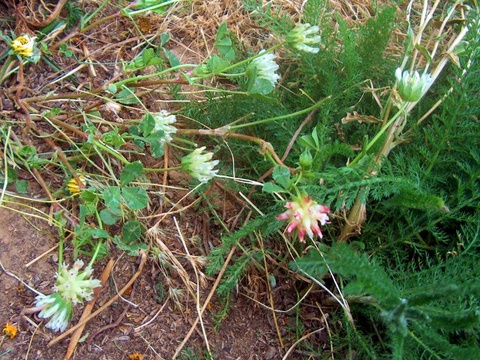 Sour clover (Trifolium fucatum) blooms in a garden in Marysville. Photo by queerbychoice. Sour clover (also called bull clover) is native to Sutter County and typically grows at elevations below 3,000 feet. It is found in central oak woodland, valley grassland, yellow pine forest, riparian forest, and freshwater marsh. It tolerates serpentine. It is equally likely to grow in wetlands or non-wetlands. Botanist Willis Linn Jepson collected sour clover on the Sutter Buttes in 1891.1
Sour clover (Trifolium fucatum) blooms in a garden in Marysville. Photo by queerbychoice. Sour clover (also called bull clover) is native to Sutter County and typically grows at elevations below 3,000 feet. It is found in central oak woodland, valley grassland, yellow pine forest, riparian forest, and freshwater marsh. It tolerates serpentine. It is equally likely to grow in wetlands or non-wetlands. Botanist Willis Linn Jepson collected sour clover on the Sutter Buttes in 1891.1
You can see pictures of it at CalPhotos, Flickr, and Picasa. You can find out where to buy it at the California Native Plant Link Exchange.
Hairy Maiden Clover
Hairy Maiden Clover (also called smallhead field clover) is native to Yuba and Sutter Counties and typically grows at elevations below 8,500 feet. It is found in central oak woodland, valley grassland, and yellow pine forest. It tolerates serpentine. Botanist Willis Linn Jepson collected smallhead field clover in Yuba City in 1891, in the area now bounded by Forbes Avenue and Bridge Street to the north and south and by Plumas Street and Clark Avenue to the east and west.2
You can see pictures of it at CalPhotos, Flickr, and Picasa. You can find out where to buy it at the California Native Plant Link Exchange.
Tomcat Clover
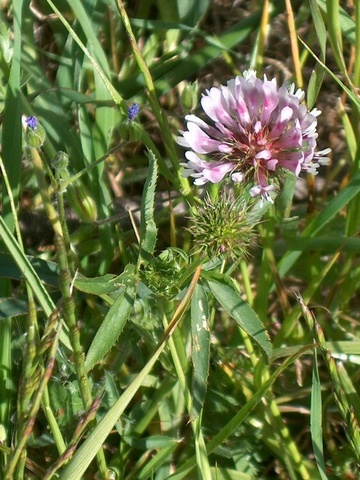 Tomcat clover (Trifolium willdenovii) in flower and bud on Table Mountain. Photo by queerbychoice. Tomcat clover is native to Yuba and Sutter Counties and typically grows at elevations below 5,000 feet. It is found in central oak woodland, valley grassland, and yellow pine forest. It tolerates serpentine. Botanist Willis Linn Jepson collected tomcat clover on the Sutter Buttes in 1891.3
Tomcat clover (Trifolium willdenovii) in flower and bud on Table Mountain. Photo by queerbychoice. Tomcat clover is native to Yuba and Sutter Counties and typically grows at elevations below 5,000 feet. It is found in central oak woodland, valley grassland, and yellow pine forest. It tolerates serpentine. Botanist Willis Linn Jepson collected tomcat clover on the Sutter Buttes in 1891.3
You can see pictures of it at CalPhotos, Flickr, and Picasa. You can find out where to buy it at the California Native Plant Link Exchange.
Indian Rancheria Clover
Indian rancheria clover is native to Sutter County and typically grows at elevations below 4,300 feet. It is most often found on slopes in central oak woodland or valley grassland. Botanist Willis Linn Jepson collected Indian rancheria clover on the Sutter Buttes in 1891.4
You can see pictures of it at CalPhotos, Flickr, and Picasa. You can find out where to buy it at the California Native Plant Link Exchange.
Pinpoint Clover
Pinpoint clover is native to Sutter County and typically grows at elevations below 5,900 feet. It is found in central oak woodland and valley grassland. Botanist Willis Linn Jepson collected pinpoint clover on the Sutter Buttes in 1891.5
You can see pictures of it at CalPhotos, Flickr, and Picasa. You can find out where to buy it at the California Native Plant Link Exchange.
Cowbag Clover
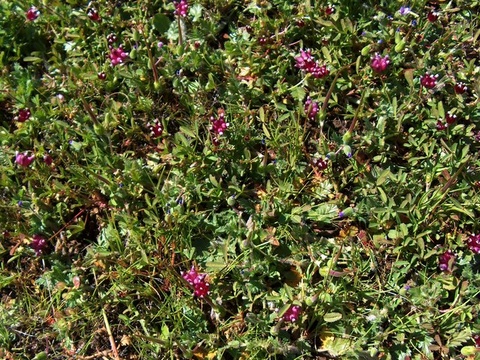 The reddish purple flowers of cowbag clover (Trifolium depauperatum) emerge from among invasive, non-native filarees on Table Mountain. Photo by queerbychoice. Cowbag clover (also called pale sack clover) is native to Yuba and Sutter Counties and typically grows at elevations below 3,000 feet. It is found in valley grassland, riparian forest, and freshwater marsh. It is equally likely to grow in wetlands or non-wetlands. Botanist Amos Arthur Heller collected cowbag clover in 1905 at what is now the intersection of Ramirez Street and East 13th Street in Marysville.6 He also collected it in 1941 on a steep, grassy hillside on West Butte Road, just west of Braggs Canyon and the Sutter Buttes.7
The reddish purple flowers of cowbag clover (Trifolium depauperatum) emerge from among invasive, non-native filarees on Table Mountain. Photo by queerbychoice. Cowbag clover (also called pale sack clover) is native to Yuba and Sutter Counties and typically grows at elevations below 3,000 feet. It is found in valley grassland, riparian forest, and freshwater marsh. It is equally likely to grow in wetlands or non-wetlands. Botanist Amos Arthur Heller collected cowbag clover in 1905 at what is now the intersection of Ramirez Street and East 13th Street in Marysville.6 He also collected it in 1941 on a steep, grassy hillside on West Butte Road, just west of Braggs Canyon and the Sutter Buttes.7
You can see pictures of it at CalPhotos, Flickr, and Picasa.
Fewflower Clover
Fewflower clover (also called mini-tomcat clover) is native to Yuba and Sutter Counties and typically grows at elevations below 3,500 feet. It is found in yellow pine forest.
You can see pictures of it at CalPhotos, Flickr, and Picasa.
Whitetip Clover
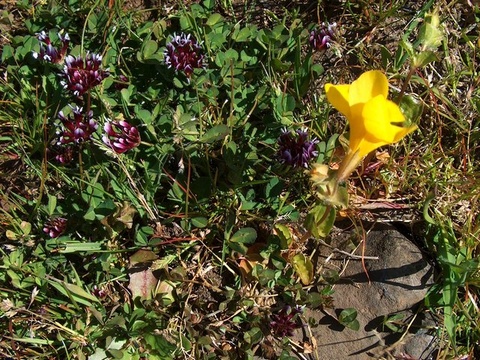 Whitetip clover (Trifolium variegatum) with a yellow seep monkeyflower (Mimulus guttatus) on Table Mountain. Photo by queerbychoice. Whitetip clover (also called variegated clover) is native to Yuba and Sutter Counties and typically grows at elevations below 8,200 feet. It is most often found in meadows in riparian forest.
Whitetip clover (Trifolium variegatum) with a yellow seep monkeyflower (Mimulus guttatus) on Table Mountain. Photo by queerbychoice. Whitetip clover (also called variegated clover) is native to Yuba and Sutter Counties and typically grows at elevations below 8,200 feet. It is most often found in meadows in riparian forest.
You can see pictures of it at CalPhotos, Flickr, and Picasa.
Bowl Clover
Bowl clover (also called cup clover) is native to Yuba County and typically grows at elevations below 8,000 feet. It is found in riparian forest.
You can see pictures of it at CalPhotos, Flickr, and Picasa. You can find out where to buy it at the California Native Plant Link Exchange.
Clammy Creek Clover
Clammy creek clover is native to Yuba and Sutter Counties and typically grows at elevations below 5,000 feet. It is found in riparian forest. It is equally likely to grow in wetlands or non-wetlands.
You can see pictures of it at CalPhotos, Flickr, and Picasa. You can find out where to buy it at the California Native Plant Link Exchange.
Pacific Grove Clover
Pacific Grove clover is native to Yuba and Sutter Counties. It is most often found in meadows in riparian forest. It is listed as rare by the state government.
You can see pictures of it at CalPhotos, Flickr, and Picasa.
Pinole Clover
Pinole clover (also called notchleaf clover) is native to Yuba and Sutter Counties and typically grows at elevations below 3,300 feet.
You can see pictures of it at CalPhotos, Flickr, and Picasa. You can find out where to buy it at the California Native Plant Link Exchange.
Foothill Tree Clover
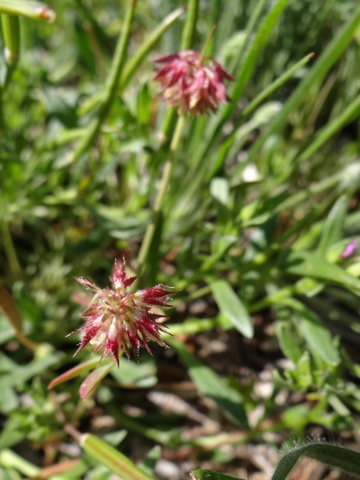 Tree clover (Trifolium ciliolatum) blooms in a garden. Photo by queerbychoice.Foothill tree clover is native to Yuba and Sutter Counties and typically grows at elevations below 5,000 feet. It is most often found on slopes.
Tree clover (Trifolium ciliolatum) blooms in a garden. Photo by queerbychoice.Foothill tree clover is native to Yuba and Sutter Counties and typically grows at elevations below 5,000 feet. It is most often found on slopes.
You can see pictures of it at CalPhotos, Flickr, and Picasa. You can find out where to buy it at the California Native Plant Link Exchange.
Footnotes
1. Consortium of California Herbaria
2. Consortium of California Herbaria
3. Consortium of California Herbaria
4. Consortium of California Herbaria
5. Consortium of California Herbaria
6. Consortium of California Herbaria
7. Consortium of California Herbaria


